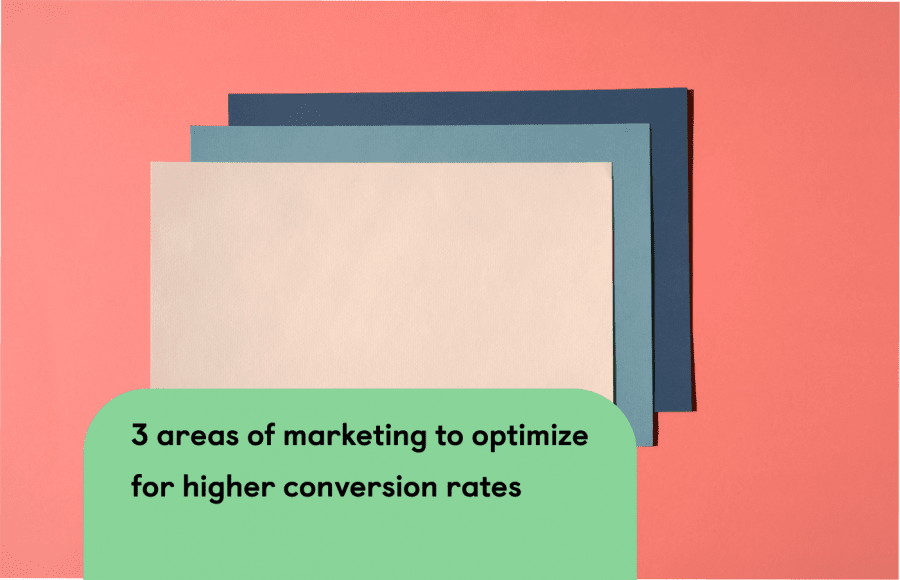![Shopping Cart Abandonment: Reasons, Stats, and Tips [Black Friday]](https://getfirepush.com/uploads/blog/09/24/3/group-9.png)
Navigation menu
When it comes to the biggest shopping weekend of the year – Black Friday – you should be targeting the marketing tools that will have the biggest impact on your sales. Sure, raising awareness of your deals and building your brand are important. But, with Americans set to spend over $1 trillion this year, your focus for Black Friday should be on getting maximum sales from your marketing spend.
That’s why many marketers turn their attention to the issue of shopping cart abandonment at this time of year. An abandoned cart is when a customer adds items to a shopping cart on your Shopify or Shopify Plus store, but then doesn’t complete the purchase.
In this guide:
- Main shopping cart abandonment reasons
- Abandoned shopping cart recovery tactics
- Shopping cart abandonment statistics
Looking for other info? Consider these guides:
- Shopify Marketing: 11 Strategies For More Sales
- 10+ Strategies to Drive Traffic to a Shopify Store [Cost & Examples]
- Best Email Marketing Apps to Promote a Shopify Store
Recover more sales with cart recovery emails
Add Shopify email app to your storeShopping Cart Abandonment Reasons [+Solutions for Black Friday]
And they are a potential gold mine, especially over the Black Friday weekend. So, in this blog, we want to take you through the main reasons shoppers abandon carts, and what you can do to manage this over the Black Friday weekend.
For each of the causes, we will also explain what you can do about abandoned cart over the Black Friday weekend.
Why do abandoned carts matter?
Abandoned shopping carts have a disproportionate effect on your overall ecommerce sales volume. That’s because they occur at the end of the sales funnel, right before a purchase is made.
Money spent on driving traffic or building your brand is all well and good, but how much impact will it have on revenue during the frenzied sales of Black Friday? Think about it:
- If you boost the click through rates on your Facebook ads by 10%, and you’ll see a small increase in revenue.
- Increase the number of customers who view a product page by 10% and the impact will be greater.
- Achieve a 10% increase in sales conversions and it will have a major impact on your overall turnover.
And it’s the fact that abandoned cart marketing is focused on conversion - turning a potential sale into an actual one - that makes it so effective.
To put it another way, even a small increase in abandoned shopping cart rate you can prevent or recover will have a big impact on your overall sales numbers. Especially on the Black Friday weekend, when volume is through the roof.
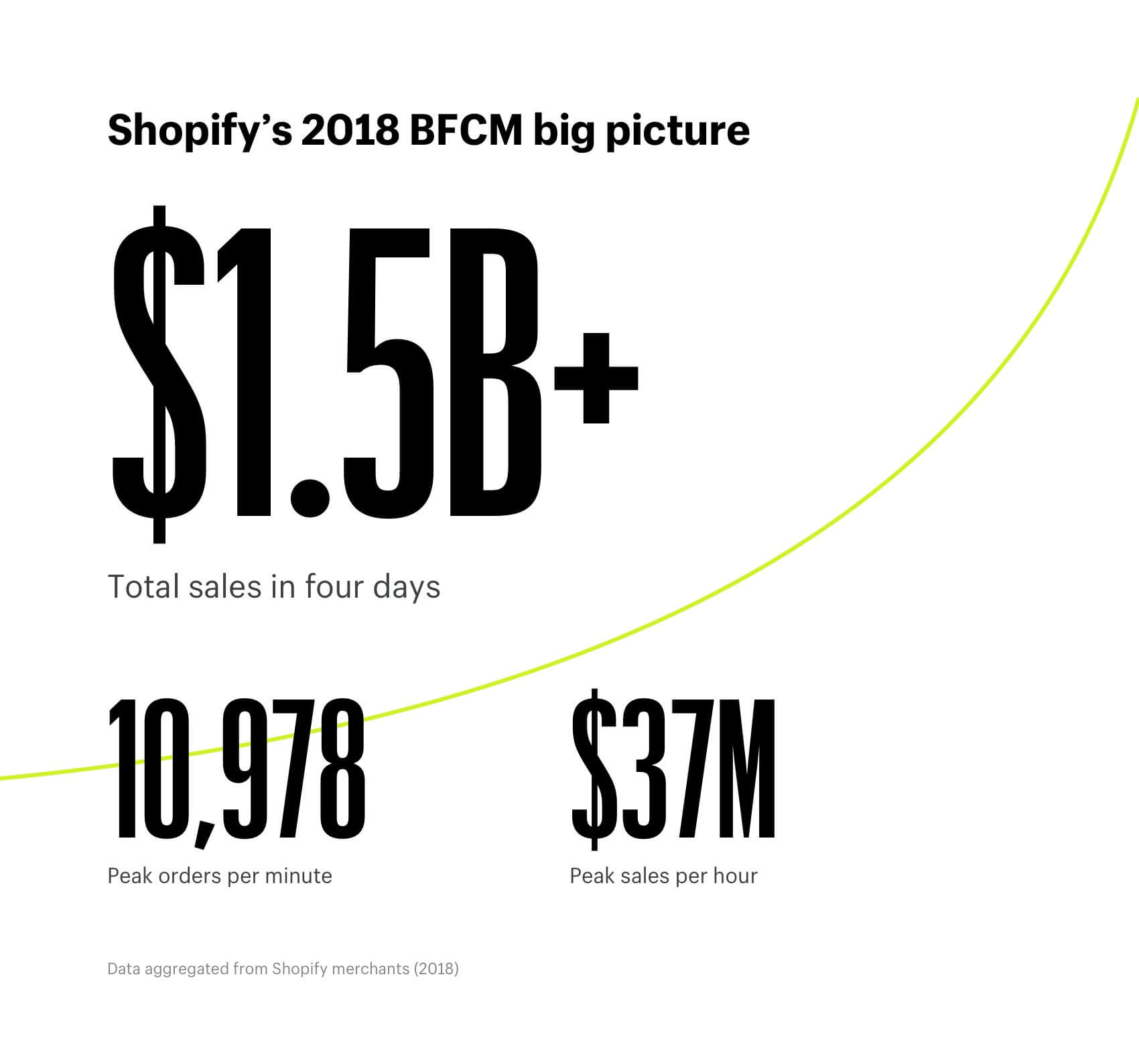
(Source: Shopify - Holiday Shopping Online)
Shopping Cart Abandonment on Black Friday
Let’s look at some concrete figures.
Abandoned cart rates vary depending on sector, region and season. The Baymard Institute has combined a number of different studies on cart abandonment. Its conclusion is that, on average, 69% of carts are abandoned. This means that of every 10 items added to a cart on an ecommerce site, 7 never end up becoming purchases. In total, it estimates that there is up to $260 billion worth of ecommerce sales for up for grabs from abandoned carts each year.
Apply the 69% figure to the $1.5 billion in sales Shopify stores enjoyed over Black Friday 2018, and you reach a startling figure.
Shopify stores could have made over $1 billion in additional sales last Black Friday if they had turned all their abandoned carts into sales.
In fact, abandoned cart rates are even higher over Black Friday - they jump by up to 5%. Which means that this $1 billion figure could be even higher. When ecommerce merchants hear that they are missing out on up a billion of sales because of shopping cart abandonment, it can cause panic.

(Source: Giphy)
But it is important to understand that abandoned carts represent an opportunity, and not a loss. This becomes clear when you dig into the data on why customers abandon carts.
Abandonment surveys - where those who abandon carts are asked why they did so - reveal some important points about customer behaviour. According to a recent cart abandonment survey, the main reasons shoppers abandon a cart without completing a purchase are:
Reasons shoppers abandon shopping carts
- They were browsing / just looking - 34%
- Shipping costs and options – 23%
- They were comparing prices – 18%
- They will buy the product in store – 15%
- Lack of payment options – 6%
- Technical issues – 4%
Out of these 6 reasons, 3 cannot really be considered lost sales – browsing, price comparison, and buying the product in store. The item was added to the cart for later reference, not because the customer was ready to make a purchase there and then.
A great way to get your head around this is to think about abandoned carts Vs abandoned checkouts:
- Abandoned shopping cart is when an item is added to a cart, but the customer never goes to checkout. In other words, the cart functions like a wish list, where customers add items they are interesting or browsing.
- Abandoned ecommerce checkout is when a customer adds items to a cart, proceeds to the checkout (presumably with the intention to buy), but then does not continue with the purchase.
If we take a look at the reasons for abandoning a cart, but now divided into these two sub-categories, the picture becomes a lot clearer.
Abandoned shopping cart:
- They were browsing / just looking - 34%
- They were comparing prices – 18%
- They will buy the product in store – 15%
Total: 67%
Abandoned ecommerce checkout:
- Shipping costs and options – 23%
- Lack of payment options – 6%
- Technical issues – 4%
Total: 33%
This break down shows us that two thirds of total abandoned carts are related to browsing and product research, while one third are related to technical issues about the checkout process – shipping, payment options, or other technical issues.
In this case, only 33% of abandoned carts can really be called lost sales. The other 67% are sales leads, and very valuable ones at that. A potential customer has arrived on your site and told you exactly what products they are interested in. This gives you an excellent opportunity to engage with them and close a sale.
Now we have made sense of the basics, let’s look at some of the specific reasons for cart abandonment in more detail. And, most importantly, let’s think about what you can do in preparation for Black Friday to address them.
Emails are the most popular way to reduce shopping cart abandonment. Here's how successful Shopify businesses do it: 15 Examples of Shopping Cart Recovery Emails.
Shopping Cart Abandonment Reason 1: "Just Browsing"
As we’ve seen from the abandonment survey results, this is the number one cause of cart abandonment. And it is also a great opportunity.
Many shoppers will be using their cart as a wish list. They browse your store, and if they see a product they are interested in they add it to their cart. On average, it takes shoppers 3 hours and 34 minutes to make a purchase. While Black Friday may be a time for more impulsive buying, online shoppers still spend time researching and considering purchases. This will be especially true if your Shopify or Shopify Plus store sells more expensive or luxury items.
In summary, browsing is a normal shopping phenomenon, and nothing to be concerned about. Quite the opposite, it is an opportunity to be grasped with both hands.
How you should prepare for Black Friday
Here are 2 smart tactics you can use to take advantage of this shopper behaviour.
Abandoned shopping cart recovery tactic 1: Omnichannel retargeting
You can use a range of channels to reconnect with these potential customers – Facebook or Google advertising, email, web push notifications, SMS, Facebook messenger, banner ads.
An omnichannel approach (using multiple channels to retarget your customers) is a smart move for a few reasons.
- Firstly, modern consumers jump across devices and channels when completing a transaction. Only using one channel is like putting all your eggs in one basket.
- Secondly, using many channels enables you to appeal to different audiences and demographics.
- And thirdly, different channels have different advantages. Retargeting via social platforms or Google doesn’t require specific permission from your customers. But on the other hand, these channels have much lower engagement and click through rates, and they’re expensive. Channels like SMS, push notifications or Facebook Messenger require specific permission, but offer much better engagement rates and ROI.
Be sure to use specific Abandoned cart messages as part of your Black Friday retargeting strategy. These can be done via omnichannel solution app. These messages will remind shoppers of the items they left in their cart. This is a really smart retargeting tactic as you know the items featured in these messages is of interest to the customer in question.
Abandoned shopping cart recovery tactic 2: Educational or brand building content
If the majority of customers who abandon a cart are just browsing, what is it that they do when they are browsing? For the answer to this, just think about how you shop for products. Once you have discovered a product you like, you want to learn more about it. How easy is it to use? What different applications does it have? What are its technical specifications, and how do these compare to other products? Is the company selling the product trustworthy and reputable? Does it have values or an identity that you resonate with?
All of these questions fit into the consideration stage of the sales funnel – the stage in between becoming aware of a product and actually making a purchase.
When ecommerce merchants think about Black Friday, they typically think of huge discounts and impulse buys. And, while it’s true that discounts matter, it’s a myth that shoppers rush into a purchase over Black Friday. On the contrary, data from Firepush users shows that shoppers spend over 3 and a half minutes browsing a website on average on Black Friday.
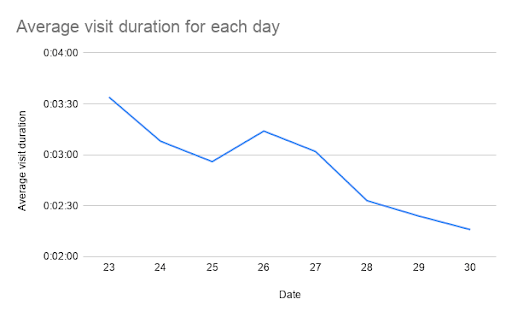
(Source: Firepush)This data is from Black Friday 2018, which was on November 23rd. Cyber Monday was on November 26th.
So, to reduce the number of abandoned carts you have, create some engaging content about your products and your brand. Explain how your products work, and how they compare to others in your range and to competitors. Build your brand using social proof (reviews, case studies) and content related to your values and mission. This way, when shoppers are researching before buying they are more likely to remain on your website to do shopping.
Decided to use emails to recover abandoned carts? Check out these 73 Abandoned Cart Email Subject Lines 2021 (+Tips) for inspiration.
Abadoned Shopping Cart Reason 2: Price Comparison
This reason accounts for almost 1 in 5 cart abandonments according to the research, so it’s an important area to consider. Like those that carts that are abandoned because the shopper is just browsing, price comparison cart abandonments should be seen as a natural part of the purchasing process, and an opportunity to engage with potential shoppers.
When shoppers are looking at comparable products, price is a key factor, especially over Black Friday when they are after deals. This could be done all online, or shoppers may be in store looking up online prices for reference – data shows that 68% of shoppers have done this at some point.
How you should prepare for Black Friday
Here are 2 ways you can deal with price comparison abandoned carts over Black Friday:
- Provide price comparisons on your site
- Send abandoned cart messages with discounts
Tactic 1: Price comparison content on your site
Like with shoppers who are just browsing, anticipating the questions or needs of these shoppers is a great way to reduce cart abandonment. So aim to have specific content on your site that will help your customers understand your prices and compare them to what’s on offer in the market.
Here are some examples of content types you can try:
Tables or graphics that compare the prices and specifications of your main products. Aim to make them visually appealing and easy to understand, and don’t forget that they will need to be responsive for mobile users.
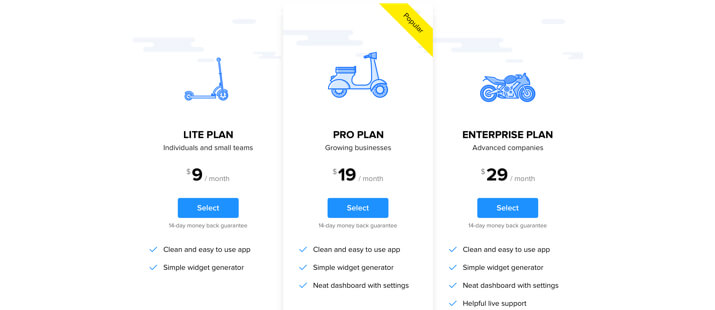
(Source: Elfsight)
Tables or graphics comparing your products to those of your competitors. Be careful not to over-emphasise your product’s benefits compared to your rivals, as shoppers won’t trust a totally one-sided table. Try to subtly show that your product offers the better value. Or if you have third-party content showing your prices in comparison to others, be sure to use this.
Savings or price calculators.These will help your customers to understand the value for money they get from your product. If you have multifunctional products, total up the cost of buying all the individual products that do what your single product does.
Tactic 2: Abandoned cart SMS, Webpush or Messenger messages offering a discount
For price sensitive shoppers, abandoned cart messages with a discount are the perfect solution. Shortly after they have abandoned their cart, you can ping them a message not only reminding them of your product, but offering an extra discount as well.
For example, last Black Friday the click through rate on abandoned cart SMSs was 13% for Firepush users. The average click through rate for retargeting ads is just 0.7%. This tells us that Black Friday shoppers really respond to abandoned cart messages.
.jpg)
(Source: Firepush)
This data shows that reaching out to customers after they abandon a cart is a very effective way to recover a sale, especially if you offer a discount as an incentive. And it is cost effective too. Rather than investing lots to find completely new customers, getting the most from those you have already attracted to your store is going to be a cost effective strategy.
Is price the leading cause of shopping cart abandonment on your store, too? Try discounts to encourage finishing the purchase. Here's How To Create Discount Codes [Guide for Shopify Store Owners].
Abadoned Shopping Cart Reason 3: Shipping
With shipping, which accounts for 23% of cart abandonments, we get onto the first factor we can refer to as a checkout abandonment. In other words, these are shoppers who are ready to purchase your product, but something has turned them off during the checkout process.
Shipping could be turning shoppers off a purchase in a couple of ways.
The first is hidden costs. Many shoppers are perfectly happy to pay for shipping – but what will make them unhappy is high shipping costs unexpectedly added at checkout. Imagine you picked up a product in a store, walked over to the checkout to pay, only to discover the price shown on the shelf wasn’t the total price you’d have to pay. Even if it’s still a good overall price, the unpleasant surprise of an extra cost may be enough for you to ditch the deal.
The second possibility is that your shoppers simply don’t want to pay for shipping at all. This is becoming increasingly common, especially with younger generations who shop online a lot. In a recent survey of Generation Z shoppers, over 50% said the number one reason they shop online was for free and fast shipping. So simply offering free shipping may be the solution to your cart abandonment problems, especially if you have a younger audience.
Let’s look at a couple of strategies you can use to reduce or recover abandoned carts due to shipping.
Cart recovery solution 1 – Be transparent about shipping costs
As we have just discussed, the surprise element of a shipping cost can be the biggest problem. So one simple solution is to be more transparent about your shipping costs. Your product pages are the place to do this. If it is not possible to give an exact shipping cost for a specific product (because of varying shipping costs depending on location, for example), at least present a price range for shoppers will have a ballpark figure. This can do a lot to soften the blow of an additional costs added to a product at checkout.
Cart recovery solution 2 – Offer free shipping, including as a cart abandonment offer
Of course the best option, if you can afford it, is to offer free shipping. You could do this in three ways:
Offer free shipping straight on all orders
Clearly this option will only be possible if the order value is going to be high enough. If you are a high-end or luxury brand, this could be an option for you. Or you can offer free shipping for certain seasons or connected with specific promotions (like this offer from Origami Owl).

Free shipping with no limits is a big deal for shoppers, so be sure to communicate heavily on this offer.
Offer free shipping with a threshold
This is the most common approach to free shipping. You set a minimum order amount shoppers have to reach to qualify for free shipping. This allows you to offer free shipping affordably, is also a smart way to drive up average order value. For example, Puravida Jewellery offer free shipping on orders of $35 or more, and use a banner at the top of their landing and product pages to promote this free shipping deal:

Offer through an abandoned cart message
Your final option is to offer free shipping via your abandoned cart messages. In this scenario, a customer adds an item to their cart then doesn’t complete the purchase. You can use automated SMS, Webpush, Facebook Messenger or email to reach out to them shortly afterwards, offering free shipping if they complete the purchase. Set a time limit on this offer to increase the urgency of the message.
Other Shopping Cart Abandonment Reasons - Payment Methods, Currency, and Returns
There are some other causes of abandoned checkouts that we should briefly address. Like shipping, these are lost sales because something in your checkout process has prevented the shopper from completing their purchase. Here are some of the most common issues that cause abandoned carts at checkouts.
1. Limited or untrustworthy payment methods
Shoppers want to know their payment details will be secure. So using a trusted and reputable payment system is critical. Furthermore, not all shoppers will be able to or want to use certain payment methods, so ensuring you offer a range of ways to pay is important. Including the icons of the payment providers you offer in the footer of your website is a simple, effective way to build trust. Here’s how the Shopify Plus store Inkedshop have done it:
.png)
(Source: Inkedshop)
2. Currency
If you are selling internationally, offering prices in a shopper’s local currency is important. According to Shopify, 33% of shoppers outside America are likely to abandon a cart if the price is only offered in US dollars. So enable multi-currency on your Shopify Plus store (it is currently not available with the standard Shopify package) and select the currencies relevant to your markets.
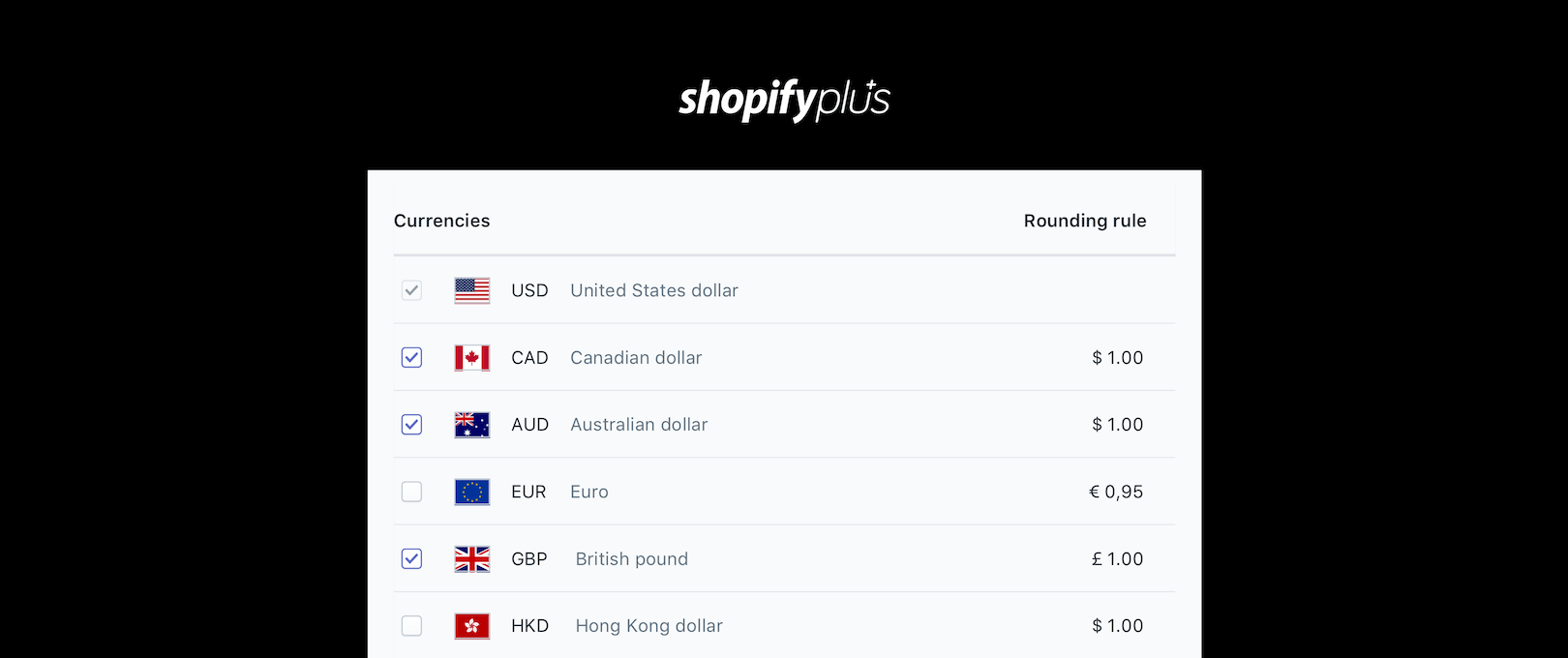
(Source: Shopify)
You can currently choose from 10 currencies: US dollars, Australian dollars, Canadian dollars, Danish Krone, Euros, Hong Kong dollars, Japanese Yen, New Zealand dollars, British Pounds, and Singapore dollars.
3. Returns
The ability to return goods is critical for ecommerce in certain sectors, especially fashion. It is also generational. According to a recent survey by Bigcommerce, Gen Z shoppers are most likely to return items bought online.
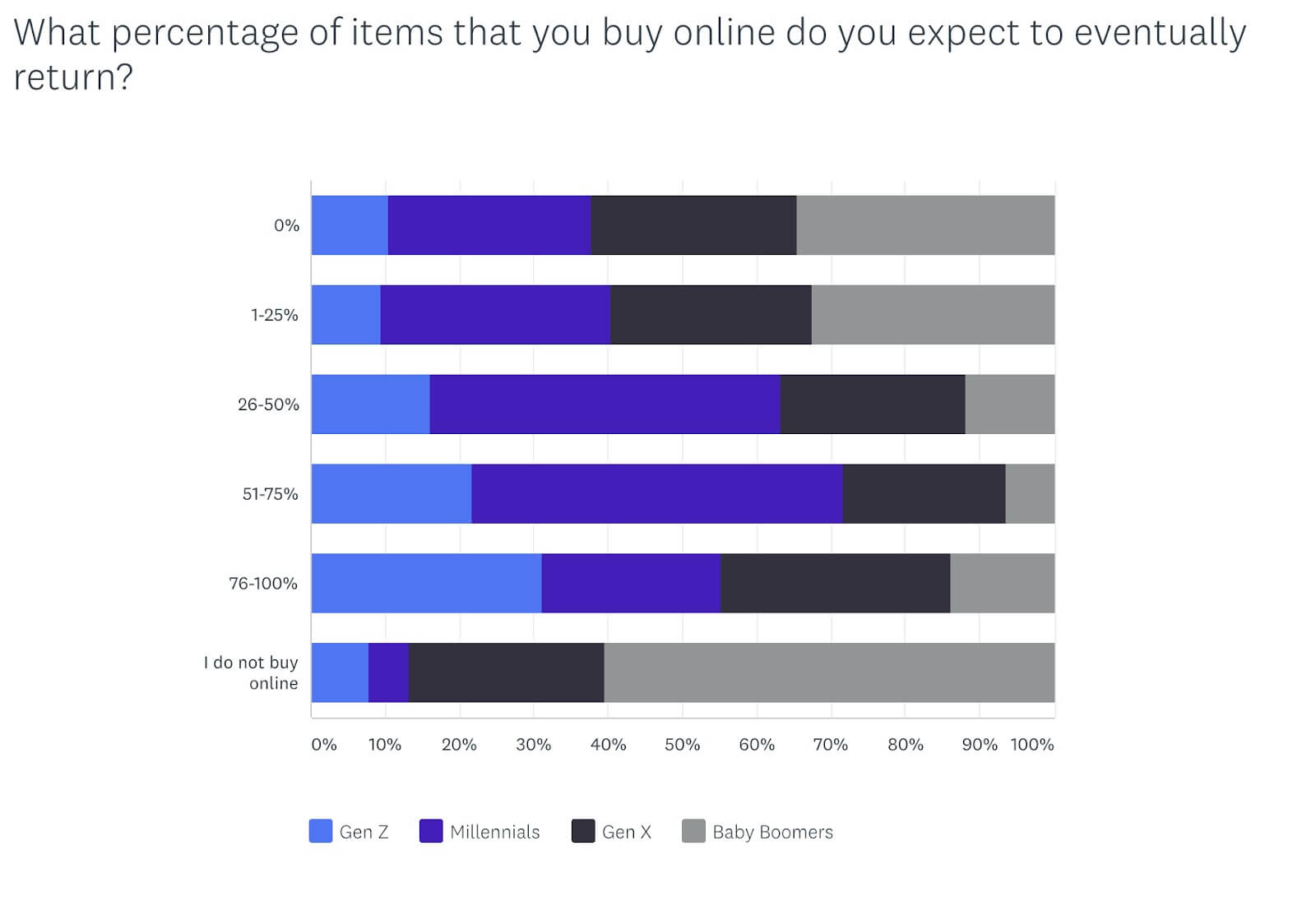
(Source: Bigcommerce)
To address this issue, offer a flexible returns policy. And if you can, free shipping on returns is a great option, especially for younger shoppers.
Use Multiple Ways to Reduce Shopping Cart Abandonment
Of course, understanding why each shopper has abandoned their cart is impossible. They could be simply browsing, or perhaps hidden shipping costs have turned them off the purchase. Because of this uncertainty, it is important to implement a range of solutions to address cart abandonment, and to carefully monitor which ones work.
- Content for customers who are browsing: Add some consideration stage content to your website, including reviews, brand building content, and price comparison tools.
- Abandoned cart messages: Set up a range of abandoned cart messages using SMS, Webpush, Facebook Messenger and email. Offer some messages that simply act as a reminder, send some offering discounts, and some offering free shipping. Test to see which of these performs best (this will also give you a useful insight as to what is causing cart abandonment on your store).
- Transparent shipping and returns information: Communicate clearly about the shipping conditions you offer, and other practical points such as returns.
- Use a user-friendly checkout: Aim to simplify your checkout process and add a range of credible payment options.




